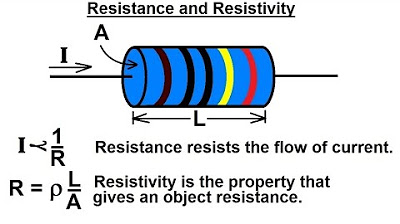ilmu bahan - Konduktor
Summary
TLDRThis script discusses various materials used in electrical conductors, focusing on aluminum and copper. It covers their properties, advantages, and applications in electrical systems, highlighting factors like resistance, conductivity, and insulation. The transcript also touches on practical considerations for selecting and using conductors in electrical installations, such as durability, cost-effectiveness, and safety. It includes references to common materials like PVC insulation and provides an overview of cables used in different scenarios, while also addressing the importance of choosing the right conductor for specific electrical needs.
Takeaways
- 😀 The concept of conductors is central to the discussion, with a focus on materials that can conduct heat or electricity efficiently, such as aluminum and copper.
- 😀 Different types of cables and their applications in electrical installations are highlighted, with an emphasis on the benefits and limitations of each type.
- 😀 Aluminum and copper are compared as conductors, with copper being the better conductor but aluminum being more affordable and lightweight.
- 😀 PVC insulation is mentioned as an important component for protecting cables from corrosion and damage, particularly in electrical installations.
- 😀 The resistance of conductors is a key factor in determining their effectiveness, with the goal being to use materials that balance high conductivity and affordability.
- 😀 Wood and paper are also mentioned as potential conductors when combined with water, though they are less efficient than metals like copper and aluminum.
- 😀 The script explores the economic aspects of using various conductor materials, noting that cost-effectiveness is crucial for their widespread adoption in the industry.
- 😀 The importance of choosing the right type of cable for electrical installations, such as those used in buildings, is emphasized.
- 😀 There is a discussion on the factors affecting the efficiency of conductors, including heat resistance, and the need for cables to withstand various environmental conditions.
- 😀 The significance of understanding electrical resistance and how it affects the overall performance of conductors in electrical circuits is stressed.
Q & A
What is a conductor in electrical terms?
-A conductor is a material that allows the flow of electric current or heat. It typically has low resistance and facilitates the easy transfer of energy.
What are some common materials used as conductors?
-Common materials used as conductors include copper, aluminum, and in some cases, water and wood when they are damp or treated.
Why is copper considered a good conductor?
-Copper is considered a good conductor because of its high conductivity, which means it can transfer electricity efficiently with minimal resistance.
What is the significance of aluminum as a conductor?
-Aluminum is lighter and cheaper than copper but is also a good conductor, though it has higher resistance. It is often used in electrical applications where weight and cost are a concern.
What happens when wood or paper is used as a conductor?
-Wood and paper can conduct electricity or heat only when they are moist or treated with certain substances. Dry wood or paper typically does not conduct well.
What is PVC insulation, and why is it used?
-PVC (Polyvinyl chloride) insulation is commonly used for electrical cables because it offers good electrical insulation properties, resistance to corrosion, and durability in various environments.
Why is the resistance value of a conductor important?
-The resistance value of a conductor determines how much it resists the flow of electric current. Low resistance allows for more efficient current flow, while high resistance can cause energy loss in the form of heat.
What role do cables with copper or aluminum insulation play in electrical installations?
-Cables with copper or aluminum insulation are essential in electrical installations because they safely transmit electricity while protecting the conductor from damage, reducing the risk of short circuits or fires.
What is meant by 'conductivity' in electrical materials?
-Conductivity refers to a material's ability to conduct electric current. A higher conductivity means that the material allows current to pass through it more easily, while low conductivity materials resist current flow.
How do factors like cable size and insulation affect electrical installations?
-The size of the cable and the quality of its insulation significantly affect the efficiency and safety of electrical installations. Larger cables can carry more current, while proper insulation prevents electrical hazards like short circuits and fires.
Outlines

This section is available to paid users only. Please upgrade to access this part.
Upgrade NowMindmap

This section is available to paid users only. Please upgrade to access this part.
Upgrade NowKeywords

This section is available to paid users only. Please upgrade to access this part.
Upgrade NowHighlights

This section is available to paid users only. Please upgrade to access this part.
Upgrade NowTranscripts

This section is available to paid users only. Please upgrade to access this part.
Upgrade NowBrowse More Related Video
5.0 / 5 (0 votes)





